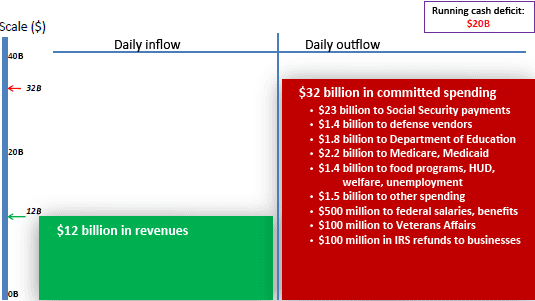Debt debacle a matter of semantics?

The Bankrate promise
At Bankrate we strive to help you make smarter financial decisions. While we adhere to strict , this post may contain references to products from our partners. Here's an explanation for .
May 16. That’s the day Uncle Sam ran out of money.
Technically, it’s the day the U.S. government hit the limit on the amount of money — $14.3 trillion — it can borrow. A cushion is necessary because federal government expenses tend to exceed the amount of money taken in.
To deal with such financial trouble, the U.S. Treasury, like many a strapped individual taxpayer, has shuffled money around and can pay America’s bills until Aug. 2.
Congress, however, is balking at raising the debt ceiling. The problem? Differing ideas on how to cover the increased borrowing authority. Options under discussion include the following.
| What’s proposed | What it would do | Who supports it |
| Cut spending | Among the cuts that would save the most money are streamlining the Department of Defense, cutting government contractors, reducing the government work force and changing government workers’ pension plans. But it’s the House Republican budget proposal to change Social Security and Medicare that has caused the most controversy. | This is the method preferred by most Republicans. But it was President Barack Obama’s own bipartisan deficit reduction panel that suggested 58 ways to cut spending. |
| End federal subsidies | This phrase typically is used to describe high-profile tax breaks, such as tax benefits for corporate jets and hedge fund managers. Obama has targeted these tax breaks in recent speeches. Also on the federal tax ax list are breaks for the oil industry, and for corn growers whose crops are used to make ethanol. | Democrats are leading the charge to end corporate tax subsidies. So far, tax breaks for oil companies have survived, but ethanol producers haven’t been as lucky. The biofuel subsidy was a target of Sen. Tom Coburn, R-Okla. And by a wide bipartisan margin, in June the Senate approved an amendment to end the ethanol tax credit, although the chances of it passing the GOP-controlled House are smaller. |
| Increase revenues | This catchall phrase generally is construed as raising taxes, either by enacting new ones or letting temporary tax breaks expire. In addition to canceling corporate tax subsidies, the president has proposed reducing the amount of itemized tax deductions that higher-income individuals can claim. This would decrease the value of deductions for medical expenses, charitable donations, property taxes and mortgage interest. | Collecting more tax money, especially from wealthier taxpayers (those individuals making more than $200,000 or $250,000 in total family income), is a key deficit-reduction plank of Democrats. So far, Republicans have remained unified and blocked such efforts. But things get trickier when sunsetting tax benefits, such as the Bush tax cuts that were extended by Obama through 2012, are discussed. There is disagreement between the parties as to whether letting an existing tax break expire counts as a hike. Democrats say no; Republicans say it does. |
| Keep things revenue neutral | This is a tax policy technique that allows the government to receive the same amount of money despite law changes. Essentially, when taxes are lowered for one group, they must be raised, or additional spending cuts made, for another group. This allows the revenue, at least on government spreadsheets, to remain unchanged (i.e., neutral). | Republican leaders are demanding revenue neutrality before they will sign off on any budget-deficit reduction plan. That means revenue from closing loopholes or eliminating corporate subsidies must be offset by new tax cuts. The problem with this approach, Democrats counter, is that if increased revenue is offset by tax breaks and cuts, nothing changes with regard to the federal deficit. |
The bottom line is that Congress must find some common ground on the debt ceiling — and soon. If lawmakers don’t act, the ramifications would be immediate. The United States would be entirely dependent upon incoming cash to cover costs.
In addition to the global effects of such a situation, many U.S. citizens who rely on federal money would find their benefits cut or gone.
The Bipartisan Policy Center, a think tank based in Washington, D.C., and founded by former U.S. senators from both parties, examined publicly available data from Daily Treasury Statements and has calculated that on Aug. 3 alone the Treasury would be $20 billion short.
And the fiscal battles won’t stop even after the debt ceiling issue is resolved. Capitol Hill is facing an Oct. 1 deadline to enact the fiscal year 2012 budget.
Related Articles



